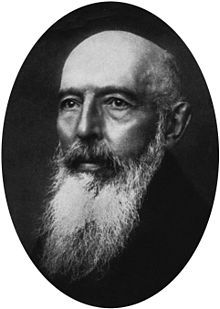Gerhard Armauer Hansen
Gerhard Henrik Armauer Hansen | |
|---|---|
 Gerhard Armauer Hansen | |
| Born | 29 July 1841 Bergen, Norway |
| Died | 12 February 1912 (aged 70) Florø, Norway |
| Alma mater | University of Oslo |
| Awards | Royal Norwegian Order of St. Olav |
| Scientific career | |
| Fields | Epidemiology |

Gerhard Henrik Armauer Hansen (Norwegian pronunciation: [ˈɡæ̂rhɑɖ ɑrˈmæ̀ʉər ˈhɑ̂nsn̩]; 29 July 1841 – 12 February 1912) was a Norwegian physician, remembered for his identification of the bacterium Mycobacterium leprae in 1873 as the causative agent of leprosy.[1][2] His distinguished work was recognized at the International Leprosy Congress held at Bergen in 1909.[3]
Life
[edit]Hansen was born in Bergen, Norway, and attended the Bergen Cathedral School. He worked at Rikshospitalet in Christiania (now Oslo) and as a doctor in Lofoten. In 1868 Hansen returned to Bergen to study leprosy while working at Lungegård Hospital (Lungegårdshospitalet) with Daniel Cornelius Danielssen, a noted expert.[4]
Leprosy was regarded as largely hereditary or otherwise miasmic in origin. Hansen concluded on the basis of epidemiological studies that leprosy was a specific disease with a specific cause.[5] In 1870–71 Hansen travelled to Bonn and Vienna to gain the training necessary for him to prove his hypothesis.[6] In 1873, he announced the discovery of Mycobacterium leprae in the tissues of all people with the condition, although he did not identify them as bacteria, and received little support.[6] The discovery was made with a "new and better" microscope.[7]
In 1879 Hansen gave tissue samples to Albert Neisser, who then successfully stained the bacteria and announced his findings in 1880, claiming to have discovered the disease-causing organism. There was some dispute between Neisser and Hansen, Hansen as discoverer of the bacillus and Neisser as identifier of it as the etiological agent. Neisser tried to downplay the assistance of Hansen. Hansen's claim was weakened by his failure to produce a pure microbiological culture in an artificial medium, or to prove that the rod-shaped organisms were infectious. Further, Hansen had attempted to infect at least one female patient with the nodular form of leprosy without consent, and although no damage was caused, the case ended up in court and Hansen lost his post at the hospital. The case helped introduce informed consent for medical research in Norway.[8][9]
Hansen remained medical officer for leprosy in Norway and it was through his efforts that the leprosy acts of 1877 and 1885 were passed, leading to a steady decline of the disease in Norway from 1,800 known cases in 1875 to just 575 cases in 1901.
Hansen had had syphilis since the 1860s but died of heart disease. He was an atheist.[10][11]
Women's rights
[edit]He was a co-founder and a board member of the Bergen chapter of the Norwegian Association for Women's Rights, led by his sister, prominent women's rights advocate Amalie Hansen.[12][13]
Honors
[edit]- Leprosy Museum (Lepramuseet) at St. Jørgen Hospital in Bergen has been dedicated to Hansen.[14]
- Haukeland University Hospital has established Armauer Hansens hus as a research facility operated by the University of Bergen.[15]
- In Jerusalem, a 19th-century leprosarium has borne Hansen's name since 1950. It has been reconstructed into an art center while preserving the physician's surname in its title.[16]
- Armauer Hansen Research Institute (AHRI) in Addis Ababa, Ethiopia under the ministry of Health is named after Hansen. AHRI is a biomedical research institute working in tuberculosis, HIV, malaria, leishmaniasis training, and research.[17]
References
[edit]- ^ Hansen GHA (1874). "Undersøgelser Angående Spedalskhedens Årsager (Investigations concerning the etiology of leprosy)". Norsk Mag. Laegervidenskaben (in Norwegian). 4: 1–88.
- ^ Irgens L (2002). "The discovery of the leprosy bacillus". Tidsskr Nor Laegeforen. 122 (7): 708–9. PMID 11998735.
- ^ Svein Atle Skålevåg. "Gerhard Armauer Hansen". Store norske leksikon. Retrieved 1 January 2017.
- ^ Jay, Venita (2000). "The Legacy of Armauer Hansen". Archives of Pathology & Laboratory Medicine. 124 (4): 496–497. doi:10.5858/2000-124-0496-TLOAH. PMID 10747301.
- ^ Irgens L; Rabson, S. M. (1984). "The discovery of Mycobacterium leprae. A medical achievement in the light of evolving scientific methods". Am J Dermatopathol. 6 (4): 337–43. doi:10.1097/00000372-198408000-00008. PMID 6388392.
- ^ a b "Gerhard Henrik Armauer Hansen". whonamedit.com. Retrieved 22 March 2007.
- ^ Bergenseren som løste lepra-gåten Aaftenposten . 16 September 2012
- ^ Ole Didrik Lærum. "Gerhard Armauer Hansen, Lege". Norsk biografisk leksikon. Retrieved 1 January 2017.
- ^ Ervik, Torill Sommerfelt (28 February 2023). "150 år siden den norske legen oppdaget leprabasillen og forandret verden". www.forskning.no (in Norwegian Bokmål). Retrieved 27 October 2024.
- ^ Biography of Gerhard Henrik Armauer Hansen whonamedit.com
- ^ Gerhard Armauer Hansen (1814–1912) Archived 23 December 2016 at the Wayback Machine Journal of the Association of Physicians of India, vol 63, March, 2015
- ^ Aasen, Elisabeth (2020). Bergens små og store døtre. Bergen: Bodoni forlag. ISBN 978-8284030722.
- ^ Bergen Kvinnesaksforening, Arkivportalen
- ^ "St. Jørgen hospital (Lepramuseet)". Medisinsk historie i Bergen. 6 May 2015. Retrieved 1 January 2017.
- ^ "Armauer Hansens hus". Haukeland universitetssjukehus. 6 May 2015. Retrieved 1 January 2017.
- ^ The Hansen Compound: From Leper Hospital to Multimedia Art Center. israelightly.wordpress.com. 31 May 2013
- ^ "Armauer Hansen Research Institute". ahri.gov.et.
External links
[edit]- 1841 births
- 1912 deaths
- Physicians from Bergen
- People educated at the Bergen Cathedral School
- University of Oslo alumni
- Norwegian atheists
- Norwegian medical researchers
- Norwegian physicians
- Leprologists
- Norwegian public health doctors
- Recipients of the St. Olav's Medal
- Norwegian Association for Women's Rights people
